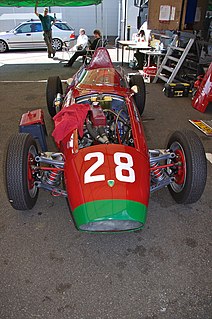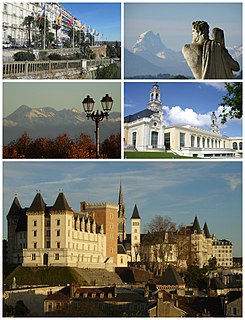
Jean-Pierre Wimille was a Grand Prix motor racing driver and a member of the French Resistance during World War II.
Grand Prix motor racing, a form of motorsport competition, has its roots in organised automobile racing that began in France as early as 1894. It quickly evolved from simple road races from one town to the next, to endurance tests for car and driver. Innovation and the drive of competition soon saw speeds exceeding 100 miles per hour (160 km/h), but because early races took place on open roads, accidents occurred frequently, resulting in deaths both of drivers and of spectators.
Maurice Bienvenu Jean Paul Trintignant was a motor racing driver and vintner from France. He competed in the Formula One World Championship for fourteen years, between 1950 and 1964, one of the longest careers in the early years of Formula One. During this time he also competed in sports car racing, including winning the 1954 24 Hours of Le Mans race. Following his retirement from the track Trintignant concentrated on the wine trade.

Hermann Lang was a German racing driver who raced motorcycles, Grand Prix cars, and sports cars.
Jean Marie Behra was a Formula One driver who raced for the Gordini, Maserati, BRM, Ferrari and Porsche teams.

Luigi Villoresi was an Italian Grand Prix motor racing driver who continued racing on the Formula One circuit at the time of its inception.

Philippe Étancelin was a French Grand Prix motor racing driver who joined the new Formula One circuit at its inception.
The European Drivers' Championship was an annual competition in auto racing that existed prior to the establishment of the Formula One world championship in 1950. It was established in 1931 and ran until the end of 1939 with a hiatus from 1933–34, and awarded points to drivers based on the results of selected Grand Prix races, the so-called Grandes Épreuves. The championship was discontinued because of the outbreak of World War II in 1939, and no champion was officially declared for the last season.

Richard John Beattie Seaman, was one of the greatest pre-war Grand Prix drivers from Britain. He famously drove for the Mercedes-Benz team from 1937–1939 in the Mercedes-Benz W154 car, winning the 1938 German Grand Prix. He died of his injuries after his car crashed into a tree and caught fire during the 1939 Belgian Grand Prix.

The Maserati 4CL and its derived sister model the Maserati 4CLT are single-seat racing cars that were designed and built by Maserati. The 4CL was introduced at the beginning of the 1939 season, as a rival to the Alfa Romeo 158 and various ERA models in the voiturette class of international Grand Prix motor racing. Although racing ceased during World War II, the 4CL was one of the front running models at the resumption of racing in the late 1940s. Experiments with two-stage supercharging and tubular chassis construction eventually led to the introduction of the revised 4CLT model in 1948. The 4CLT was steadily upgraded and updated over the following two years, resulting in the ultimate 4CLT/50 model, introduced for the inaugural year of the Formula One World Championship in 1950. In the immediate post-war period, and the first two years of the Formula One category, the 4CLT was the car of choice for many privateer entrants, leading to numerous examples being involved in most races during this period.

The Alfa Romeo 308 or 8C-308 is a Grand Prix racing car made for the 3 litre class in 1938, only four cars were produced, actually modified from Tipo C with the engine mounted lower into the chassis and a slimmer body. The chassis was derived from the Tipo C and the engine from the 8C 2900. The 308 was engineered by Gioacchino Colombo under the control of Enzo Ferrari who was then in charge of Alfa's racing team, Alfa Corse. The car debuted at the Pau Grand Prix in 1938, where two cars were entered to race, one for Tazio Nuvolari and the other for Luigi Villoresi. Both drivers had to withdraw from competition, however Nuvolari had by then set a lap record. The next race was the Tripoli Grand Prix. The new 312 and 316 were entered, but they had engine trouble during practice and Clemente Biondetti took the start at the wheel of the 308 held in reserve. He failed to finish, while Hermann Lang, driving a Mercedes-Benz W154, was the winner. In this race, Eugenio Siena, driving a 312, was killed after hitting a wall.

Arzani-Volpini was an Italian Formula One constructor, established by Gian Paolo Volpini and engine-builder Egidio Arzani.
The 1950 Pau Grand Prix was a non-championship Formula One motor race held on 10 April 1950 at the Pau circuit, in Pau, Pyrénées-Atlantiques, France. It was the first race of the 1950 Formula One season, and was conducted on the same day as the 1950 Richmond Trophy. The 110-lap race was won by Maserati driver Juan Manuel Fangio after starting from pole position. Luigi Villoresi finished second in a Ferrari, and Louis Rosier third in a Talbot-Lago.

The 1952 Pau Grand Prix was a Formula Two motor race held on 14 April 1952 at the Pau circuit, in Pau, Pyrénées-Atlantiques, France. The Grand Prix served as the first round of the French Formula Two Championship and was won by Alberto Ascari, driving the Ferrari 500. Louis Rosier finished second and Jean Behra third.
The 1933 Pau Grand Prix was a motor race held on 19 February 1933 at the Pau circuit, in Pau, Pyrénées-Atlantiques, France. It was the inaugural Pau Grand Prix, although the numbering of the races may not have reflected this due to a confusion about the 1901 race at Pau. The Grand Prix was won by Marcel Lehoux, driving the Bugatti T51. Guy Moll finished second and Philippe Étancelin third.

The 1947 Pau Grand Prix was a non-championship Formula One motor race held on 4 April 1947 at the Pau circuit, in Pau, Pyrénées-Atlantiques, France. The Grand Prix was won by Nello Pagani, driving with the Maserati 4CL. Pierre Levegh finished second and Henri Louveau third.

The 1948 Pau Grand Prix was a non-championship Formula One motor race held on 29 March 1948 at the Pau circuit, in Pau, Pyrénées-Atlantiques, France. The Grand Prix was won by Nello Pagani, for the second time running, driving the Maserati 4CL. Yves Giraud-Cabantous finished second and Charles Pozzi third.

The 1951 Pau Grand Prix was a non-championship Formula One motor race held on 26 March 1951 at the Pau circuit, in Pau, Pyrénées-Atlantiques, France. The Grand Prix was won by Luigi Villoresi, driving the Ferrari 375. Louis Rosier finished second and Giuseppe Farina third.

The 1999 Pau Grand Prix was a Formula Three motor race held on 23 May 1999 at the Pau circuit, in Pau, Pyrénées-Atlantiques, France. The Grand Prix was won by Benoît Tréluyer, driving for Signature Team. Sébastien Dumez finished second and Peter Sundberg third.











